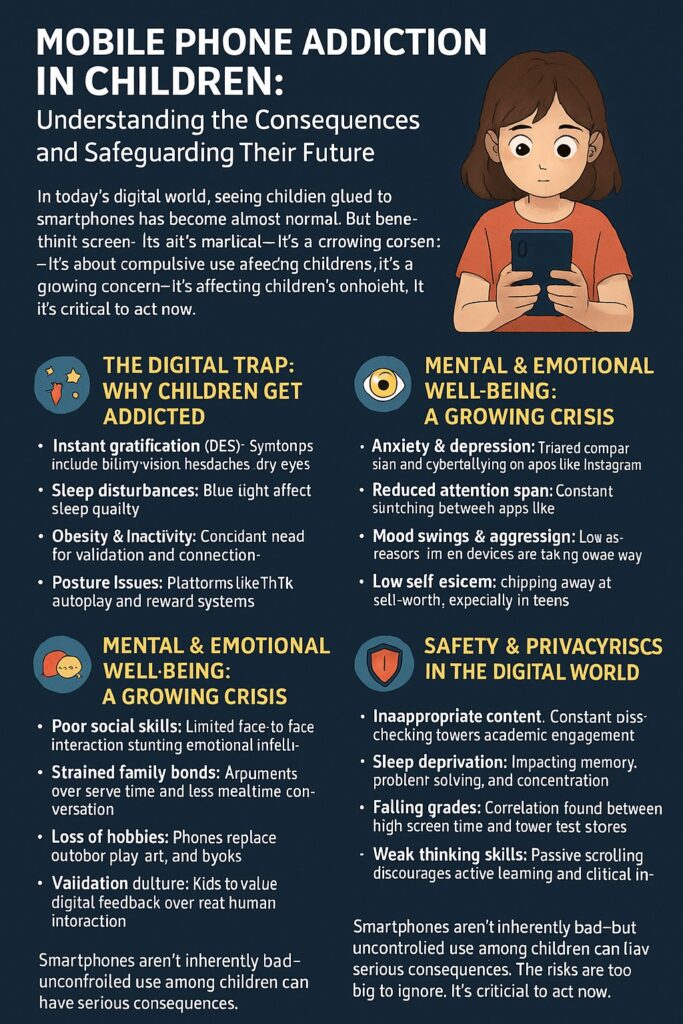
Introduction
In today’s digital world, seeing children glued to their smartphones has become almost normal. But beneath this screen-bound silence lies a growing concern: mobile phone addiction. This isn’t just about screen time—it’s about how compulsive use of smartphones is affecting children’s physical, emotional, and social development. This article explores the real consequences and why it’s critical to act now.
1. The Digital Trap: Why Children Get Addicted
Children are drawn into smartphones because they offer:
- Instant gratification: Games, YouTube, and notifications trigger dopamine, the brain’s reward chemical.
- Endless novelty: There’s always something new—an algorithmic trap designed to keep them scrolling.
- FOMO (Fear of Missing Out): Social media apps fuel a constant need for validation and connection.
- Addictive design: Platforms like TikTok and games are engineered for maximum engagement through autoplay and reward systems (APA).
2. Physical Health: The Silent Toll on Their Bodies
Smartphone addiction silently affects a child’s health:
- Digital Eye Strain (DES): Symptoms include blurry vision, headaches, and dry eyes (NIH Study on DES).
- Sleep disturbances: Blue light delays melatonin release, affecting sleep quality (Sleep Foundation).
- Obesity & inactivity: Excessive screen time contributes to sedentary behavior and weight gain.
- Posture issues: Extended phone use leads to “tech neck” and poor spinal alignment.
3. Mental & Emotional Well-being: A Growing Crisis
Phones affect more than just physical health—they impact emotions too:
- Anxiety & depression: Social comparison and cyberbullying on apps like Instagram can trigger mental health issues (WHO Adolescent Health).
- Reduced attention span: Constant switching between apps trains the brain for distraction.
- Mood swings & aggression: Withdrawal symptoms when devices are taken away are now common.
- Low self-esteem: The need for likes and validation can chip away at self-worth, especially in teens.
4. Social & Developmental Impacts: Eroding Real-World Skills
Excessive screen time weakens children’s ability to connect in the real world:
- Poor social skills: Limited face-to-face interaction stunts emotional intelligence.
- Strained family bonds: Arguments over screen time, less mealtime conversation.
- Loss of hobbies: Phones replace outdoor play, art, and books.
- Validation culture: Kids learn to value digital feedback over real human interaction.
5. Academic Performance & Cognitive Development
Mobile addiction often affects school performance:
- Reduced focus: Constant device checking lowers academic engagement.
- Sleep deprivation: Impacts memory, problem-solving, and concentration (NCERT Study).
- Falling grades: Correlation found between high screen time and lower test scores.
- Weak thinking skills: Passive scrolling discourages active learning and critical thinking.
6. Safety & Privacy Risks in the Digital World
Smartphones also pose real-world dangers:
- Inappropriate content: Children may encounter violent, sexual, or manipulative material unintentionally.
- Cyberbullying: Both victims and aggressors often operate anonymously.
- Online predators: Social media makes it easier for predators to contact kids.
- Data tracking: Many free apps collect personal data without clear consent (UNICEF Data Privacy Report).
Conclusion
Smartphones aren’t inherently bad—but uncontrolled use among children can have serious consequences. From health and emotional issues to academic decline and safety concerns, the risks are too big to ignore. As parents and caregivers, the goal isn’t total restriction, but balance.
Set digital boundaries, talk to your child about online behavior, and encourage alternative activities like sports, reading, or creative play. The digital future is here—but it’s up to us to guide our children safely through it.
Author Bio
Written by the PulseWire editorial team – a group of passionate digital writers dedicated to simplifying complex topics and delivering timely, reliable, and reader-friendly content across business, tech, health, and lifestyle domains.
Article Information
Published Date: June 19, 2025
Last Updated: June 19, 2025









